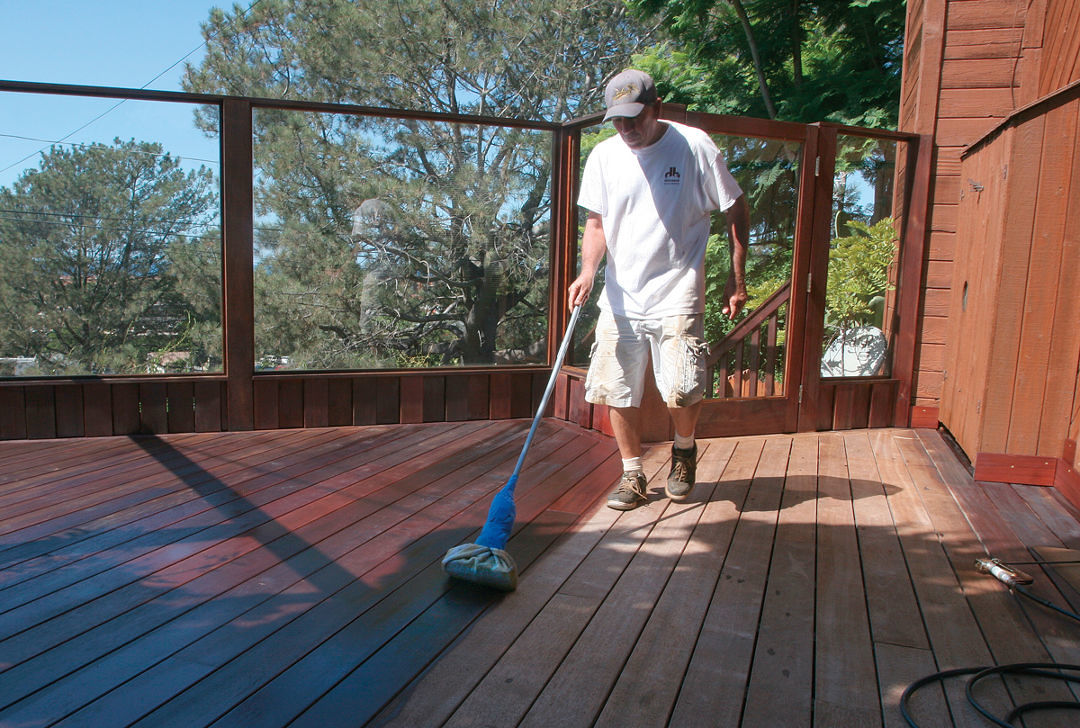Are you looking to refinish your deck? Tired of scrubbing, scraping, and sanding by hand? It’s time to invest in a sander and simplify the job.
Here you’ll find all the tips you need to get started on this project quickly and easily. You’re just moments away from your beautifully-refinished deck!
Refinishing a deck can be an involved procedure that requires considerable time, effort and expense. Sanding is an integral part of the refinishing process, as it facilitates the successful application of paint or sealant and can help to repair minor damage. With the right sanding technique, you can restore your deck’s smooth surface for a beautiful, long-lasting finish. This guide provides step-by-step instructions for using a sander to refinish a deck.
It is important to keep in mind that before getting started you should always check the integrity of the wood and replace any rotten or damaged boards with new ones; consult your local building inspector for guidance on safety requirements and applicable building codes. Once this prepping has been completed and all necessary safety precautions have been taken into consideration, you are ready to begin sanding!
Safety Precautions
It is important to take safety precautions before beginning a project with a sander. Before starting, make sure you have the right protective gear, and that you are familiar with the operation of your power tool. Here are some important tips to keep in mind:
- Always wear personal protective equipment (PPE), such as goggles, safety glasses, dust masks, ear plugs, and gloves when sanding;
- Make sure that your workspace is well ventilated to clear away any dust particles or fumes that may result from the refinishing process;
- Inspect your power tool before each use to ensure that it is in proper working order and can safely be operated;
- Ensure that your cords are long enough so that you can easily move throughout the area without becoming entangled;
- Unplug your sander between uses or when done for long periods of time;
- Keep children and pets away from work area when operating sander;
Importance of safety precautions when using a sander
When working with power tools, safety should always be the number one priority. When using a sander to refinish a deck, several safety measures need to be taken. Follow the manufacturer’s instructions carefully, especially regarding proper clothing and protective equipment such as wearing goggles, dust-proof masks and ear muffs. Secure any loose items nearby that could be accidentally damaged or become a tripping hazard for you. Inspect your sanding pads for wear and tear before use, and replace them as needed.
Store all solvents in a safe area away from flammable objects and heat sources. And last but not least – make sure someone else is aware of your whereabouts while you are doing the work. Even if you are vigilant and take all necessary precautions, accidents can still occur when working with power tools – so always monitor your environment and remain aware of who is around you while operating a sander!
Safety equipment needed
Before you begin the refinishing project, it is important to ensure that you have the right safety equipment. For sanding a deck, you will need: hearing protection such as ear defenders; safety goggles; a dust mask; and a full face shield if the power sander throws up any debris.
Before beginning work, check all of your tools and accessories to make sure they are in good working order. Make sure all hoses are correctly attached and that there are no cuts or splits in them. Also make sure any clamps or other attachments are securely fastened as these can pose a hazard when sanding at high speed.
Whenever possible, use an extension cord when using power tools outdoors so that it remains out of your way while working on the deck.
Safety tips
Whether you are a novice or an experienced handyperson, any sander project requires that you take precautions to protect your safety and the quality of your work. Before you begin working with a sander on your deck, it is important to point out a few key safety tips. These simple measures can help ensure that you complete your project safely and efficiently.
-Wear protective gear such as safety glasses, ear plugs, and a dust mask to protect yourself from wood chips and sawdust. -Avoid using too much force when pushing a sander — this can damage the deck, as well as cause personal injury. -Ensure proper ventilation by opening windows or doors near your work area in order to prevent inhalation of sawdust particles from causing illness or an allergic reaction. -Be aware of where hands, fingers, and feet are at all times while operating the sander; check for things like nails before beginning any project with tools. -If sanding near water or other liquids, be sure to wear non-slip shoes and stay away from wet areas while operating the machine.
Preparation
Before you begin using a sander to refinish your deck, it is important that you properly prepare the surface. This includes removing any furniture, planters, and other objects that are on the deck, as well as cleaning and repairing the existing surface. Once all of these steps are complete, it is time to start sanding.
The proper preparation of a deck before sanding includes:
- Remove all objects from the deck: Before beginning your work, it is important that you remove any furniture and decorative items from the deck. Anything that does not permanently attach to the surface should be moved out of the way or removed completely before beginning any sanding process.
- Clean Deck: The next step in your preparation process includes washing and scrubbing down your existing deck’s surface with a mild detergent solution and hose sprayer or pressure washer in order to remove any remaining dirt or debris on the surface of your finished wood planks. Then let it dry completely.
- Inspect for Damage & Repairs: Now it’s time to inspect for any damaged sections of wood on your existing patio cover/deck surface before you start using a sander to refinish areas of exposed wood planks — if there are any visible sections of broken boards or warped pieces they should be addressed prior to starting sanding otherwise they may prevent you from achieving a uniform finish across your entire outdoor space after completion of this project.

Steps to prepare the deck for sanding
Before you begin any deck project, it is essential that the surface is clean and prepped. This is especially important when sanding a deck because a smooth finish cannot be achieved without proper preparation. Here are some key steps to ensure that your sanding project is successful:
- Clean the surface of your deck thoroughly using a pressure washer. This will help remove dirt and debris, as well as any loose nails or screws.
- Inspect the deck for signs of damage such as splintering or cracks in the boards. Make any necessary repairs before sanding to prevent further damage from occurring during the process.
- Remove any remaining stains or paint from the wood by using a chemical stripper or light-duty sander, paying particular attention to tight spaces and corners that may have been missed in earlier stages of cleaning or repairs.
- Vacuum the surface to remove dust and other particles left behind by stripping and cleaning efforts before starting to sand with a belt sander to create an even, smooth finish on all sides of each board prior to applying any sealants and finishes For areas such as hand-rails or trim that cannot be reached with a belt sander, use an orbital sander instead.
- Go over all surfaces once again with either 150-grit sandpaper wrapped around a block, or 80-grit paper used with an orbital sander, resulting in an even smoother finish than what can be accomplished with belt sanders alone.
Inspecting the deck for any repairs needed
Before beginning the refinishing process, it’s important to inspect the deck for any repairs that may be needed. Look for any loose nail heads, rotted boards or unstable boards. If any of these defects are present, make sure to repair them before you start sanding. Make sure all boards are firmly attached and securely fastened.
Additionally, inspect rafters and joists for signs of decay and replace them if necessary. Also pay particular attention to support beams as these will help determine how much weight your deck can support after completing your refinishing project.
Clearing the deck of furniture, plants, and other obstacles
Before starting the sanding process, it is important to clear your deck of all furniture, plants, and other obstacles that may be in the way. This will help you create a clean and uncluttered workspace and make sure that you don’t miss any areas when sanding. It can also help reduce the chance of mishaps while working with a sander.
Use tarps, tarps, or a dropcloth to catch sawdust and other debris from sanding as you go along. Additionally, if your deck has any railings or built-in features such as benches or planters, be sure to cover them with plastic sheeting or canvas so that they do not accidentally get caught up in the sanding process.
Maintenance
Once you’ve completed the sanding process, it’s important to keep your deck in top condition. This includes regular cleansing, staining and sealing. Cleaning your deck removes dirt, bacteria and bird droppings which all can damage wood if not attended to quickly. Using a power washer may remove the need for sanding more often, as most best wood cleaners help preserve your deck.
Staining and sealing help protect your deck from the elements while also giving it a good look. Once you’ve applied the stain or sealer of your choice, wait a full 24 hours for it to dry before exposing it to outdoor elements. Be sure to apply additional coats when needed, usually about every 2–4 years depending on weather conditions and wear of the surface.
To maintain your sander in good condition, be sure to:
- Regularly check for loose or missing parts
- Clean dust traps periodically
- Change out old or malfunctioning parts
- Use manufacturer recommended oil
- Use manufacturer recommended sandpaper grades and grits
Making sure that you follow these steps and properly maintain both your sander and your refinishing projects will help ensure a long lasting finish that looks great year after year!
Tips for maintaining the refinished deck
Once you have completed the refinishing process of your deck, proper maintenance is essential to keep it looking its best. Below are some tips to help you keep your deck in an excellent condition:
- Clean regularly – Cleaning your deck on a regular basis will help to prevent dirt and debris from accumulating, which can cause discolouration of the wood’s surface and lessen its lifespan. Regularly rinsing the deck with a water hose or mild-detergent solution can help to keep it clean; for more stubborn stains, consider hiring a pressure washer for deep cleaning.
- Seal regularly – Applying a sealant will protect the wood against staining, discoloration and mildew formation. You should always check with the manufacturer’s instructions on how best to apply sealant since frequency and amount can differ depending on type of sealant being used.
- Monitor growths – If you live in an area where mold or mildew are an ongoing problem, check your deck periodically for any signs of growths or discolorations that could indicate the presence of these spores. If needed, use mild-detergent products designed specifically for mold removal when cleaning your deck.
- Check nails often – Any loose nails should be immediately replaced as they can cause damage to surrounding boards and become tripping hazards over time if left unchecked; always use galvanized nails that have been properly treated with a rust inhibitor coating when replacing rusty screws or nails in your wooden decks.
Regular cleaning and sealing
A regular cleaning and sealing routine can help you maintain the value of your deck and extend its lifespan drastically. Cleaning is a crucial step for any type of deck maintenance, regardless of the kind of sander you are using to refinish your deck. Cleaning with a pressure washer or special solution will help to remove dirt, grime, and potentially harmful substances that accumulate over time.
Sealing your deck with an appropriate finish will help protect it from environmental elements and should be done after sanding if no seal has previously been applied. It is important to carefully choose the right sealant product depending on the type of wood in your deck and make sure to apply the sealant thoroughly, paying special attention to areas where wood meets metal hardware or joints. Sealing should generally be repeated at least once every few years, depending on the severity of outdoor conditions.
Conclusion
In conclusion, sanding your deck is a great way to refinish and restore its beauty. Taking the time to properly prepare your deck before beginning the sanding process ensures that your end result will be a beautiful, durable finish. Be sure to start with the coarsest paper grade and move through the lighter grades until you achieve the desired finish.
Keep in mind, too, that it’s important to use a dust mask throughout the sanding process to avoid breathing in harmful particles. Finally, consider pressure-washing your deck prior to starting any type of refinishing job to ensure that it’s free of dirt and debris that could clog or damage your sander. With these tips in mind, you’re ready to begin!
FAQ’S
What is the best method for sanding a deck?
The best method for sanding a deck is to use a floor sander or a drum sander.
How do you sand a deck for refinishing?
To sand a deck for refinishing, start by removing any loose paint or stain with a scraper, then use a floor or drum sander to sand the entire deck, and finish with a hand sander for corners and edges.
Can I use a sander on my deck?
Yes, you can use a sander on your deck. A floor sander or drum sander is recommended for large areas, while a hand sander can be used for corners and edges.
Can I sand my deck with a hand sander?
Yes, you can sand your deck with a hand sander for corners and edges. However, for large areas, a floor sander or drum sander is recommended.
Should I sand my deck wet or dry?
You should sand your deck when it is dry. Sanding a wet deck can cause the wood fibers to become clogged and result in a rough surface.
Should I wash deck after sanding?
Yes, you should wash your deck after sanding to remove any dust and debris. This will ensure a clean surface for refinishing.
How long does it take to sand a deck with a hand sander?
The time it takes to sand a deck with a hand sander depends on the size of the deck and the condition of the wood. It can take several hours or even days to sand a large deck with a hand sander.
Is it worth sanding a deck?
Yes, sanding a deck is worth it as it helps to remove any old paint or stain and prepares the wood for refinishing. This can help to extend the life of your deck and improve its appearance.
Can you sand a deck too much?
Yes, you can sand a deck too much, which can result in a surface that is too smooth and doesn’t allow new stain or paint to adhere properly. It is important to follow the manufacturer’s instructions for sanding.
Why clean deck before sanding?
Cleaning your deck before sanding removes any dirt, debris, or mold that may be present on the surface. This helps to ensure a clean surface for sanding and improves the adhesion of the new stain or paint.
See more:
- Best detail sander 2023
- Best disc sander 2023
- Best drum sander 2023
- Best drywall sander 2023
- Best hand sander 2023


